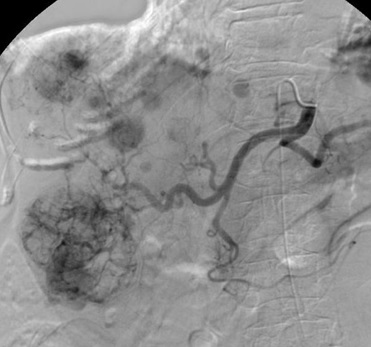What is transarterial chemoembolization?
 Transarterial chemoembolization (TACE) is a treatment for liver cancer.
Transarterial chemoembolization (TACE) is a treatment for liver cancer.
This can be a cancer originating in the liver or a cancer that has spread (metastasized) to the liver from other areas of the body.
Chemoembolization is a minimally invasive treatment that can be used when there is too much tumor to treat surgically or through percutaneous methods such as RFA or microwave ablation. Sometimes it can be used in combination with percutaneous ablation. During chemoembolization, chemotherapy drugs or beads coated with chemotherapy are injected into the artery that supplies blood to the tumor in the liver. This disrupts the blood supply to the tumor and also delivers concentrated doses of chemotherapy to the tumor or tumors.
Who benefits from this procedure?
Remember, chemoembolization only treats tumors in the liver and will have little or no effect on any other cancer in the body. Some of the liver cancers may be treated by chemoembolization are hepatoma or hepatocellular carcinoma (primary liver cancer), metastasis to the liver from colon cancer, carcinoid, ocular melanoma, or sarcomas.
How do I prepare for the procedure and what is it like?
Before the procedure, you may have blood tested to determine how well your kidneys and your blood clotting are functioning. You should inform your doctor of all medications you are taking, including any herbal supplements. Inform us of any allergies, particularly to local or general anesthetic medications or to contrast materials (sometimes called X-ray dye) or to latex gloves. Always inform your doctor if you are or may be pregnant.
Eat a light meal the evening before. You will be instructed not to eat or drink after midnight before the procedure, and if you are diabetic you should receive instructions from your doctor about adjusting medications and insulin dose on the day of the procedure. You will also need a ride home with a friend or relative.
You will likely be asked to remove your clothing and wear a gown during the procedure. Once at the hospital you will receive an intravenous (IV) line and likely a set of labs will be obtained.
You will meet your interventional radiologist and the staff who will be assisting in the procedure. Local anesthetic causes a stinging or burning sensation. Conscious sedation will make you feel relaxed and sleepy, but you likely remain awake.
The interventional radiologist will place a small catheter (tube) through an artery in your groin and into the arteries to the liver. After these arteries are identified, the catheter is directed into the branch of the artery supplying blood to the tumor, and the chemoembolization mixture or beads coated with chemotherapy is injected. The procedure usually takes approximately one hour.
Once this is completed, you are sent back to your room where you will lie flat in bed for two to six hours. Most patients are discharged from the hospital the following day.
Are there any side effects or potential complications?
Following the procedure you may have varying degrees of pain, fever and nausea. These symptoms may last a few hours to a few days, and are easily treated by various medications. Patients typically experience lower than normal energy levels for a week or so after the procedure.
Serious complications from chemoembolization are rare. In less than 3 percent of the procedures, the liver tumor killed by the procedure may become infected and/ or form an abscess. Liver failure can occur in less than 1 percent of cases.
Will chemoembolization help me?
Remember this is a treatment, not a cure. Approximately 70 percent of the patients will see improvement in the liver, and depending on the type of liver cancer, it may improve your survival.
Chemoembolization can be extremely effective in treating primary liver cancers, especially when combined with other therapies. It has also shown promising results with some types of metastatic tumors.
How will I get the results of this procedure?
The interventional radiologist will be able to inform you whether the procedure was technically successful.
Your oncologist will order follow-up imaging to determine the clinical success of the procedure and whether or not additional procedures or treatments may be necessary.
Radiologyinfo.org for Patients
The radiology information resource for patients. RadiologyInfo.org tells you how various X-ray, CT, MRI, ultrasound, radiation therapy and other procedures are performed. It also addresses what you may experience and how to prepare for the exams. The website contains over 200 procedure, exam and disease descriptions covering diagnostic and interventional radiology, nuclear medicine, radiation therapy and radiation safety and is updated frequently with new information. All material on the RadiologyInfo.org website is reviewed and approved by experts in the field of radiology from the ACR and RSNA, as well as other professional radiology organizations.
